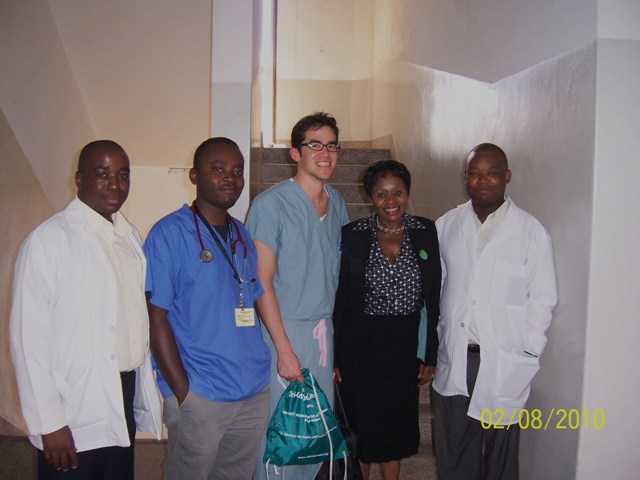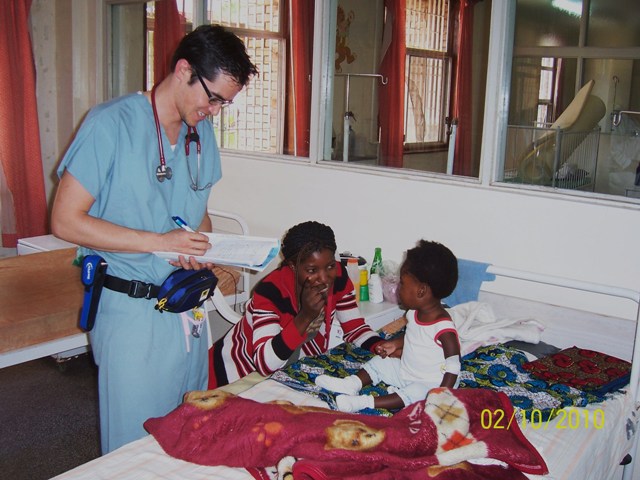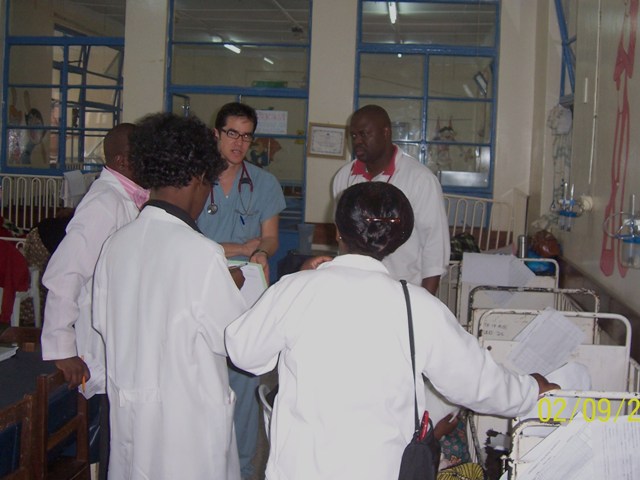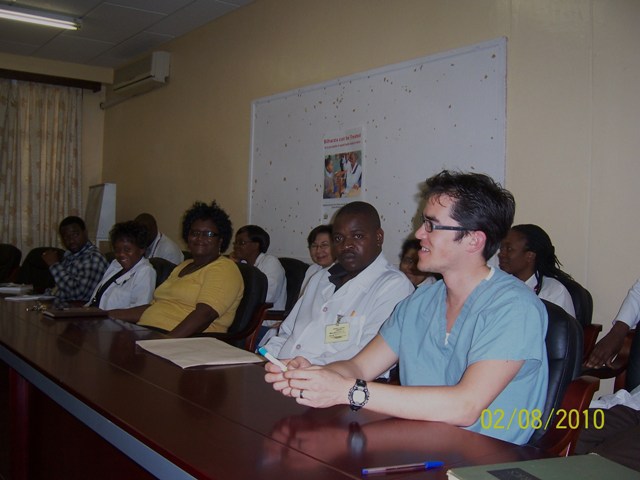Written by Hongyu Zhao, MD, PGY-2 and Qing Meng Zhang, MD, PGY-2 at Kaiser Permanente…
Hello from Lusaka!
Posted by Kevin Quinn, MD (a second year resident from Kaiser Permanente Oakland Pediatrics serving a global health elective at University Teaching Hospital in Lusaka, Zambia)
If anyone was eagerly awaiting news, I apologize- internet access here can be difficult to obtain. I’ve been in Zambia for 1.5 weeks now, and have spent the vast majority of that time at the University Teaching Hospital (UTH). It has about 350 pediatric beds, although that can be misleading because when there are more patients than beds you just start putting 2 kids in each bed, then 3, etc. It is the only tertiary care center in the country (of 14 million people or so, of which probably half are children if standard sub-Saharan African demographics apply), but also is the only public health hospital in Lusaka (population 2-3 million) so bears the burden of not only advanced pathology but volume as well.
There are no appointments, so parents show up with their kids in the morning and wait in line in either the clinic or emergency room- I think we finally got through the queue at 4am last night. Once admitted, mothers (or fathers, or often some random assortment of extended family members) sit next to their child’s bed in plastic lawn chairs. There is usually one nurse per 30-40 patients, so obviously a large portion of the child’s care (feeding, bathing, waving away flies, etc) is done by the bedside parent. There’s an epidemic of ruleout sepsis lately (called “presumed sepsis” here because it’s difficult to rule it out without urine and CSF cultures), reasonably well-appearing neonates who pop fevers and are admitted. It would be fantastic if someone would do a study on these babies to find what the incidence of serious bacterial infection is – I doubt it’s the 10% that we’ve quoted from studies in the developed world. It’s 90+ degrees outside and babies are swaddled in 4 blankets then strapped to mom’s chest as she walks home from the hospital in the blazing sun, maybe these kids should get a degree Celsius or 2 leeway. As it is, the ward is filled with moms on postnatal day one or two, uncomfortably sitting in a plastic lawn chair as they receive some length of therapy from 5-10 days of penicillin and gentamicin.
The most heavily hit unit is the malnutrition ward, which has double or triple booked its beds and has a single sink for sanitation. The mortality is ~50%, and I’ve heard there are issues with culture in that mothers can become disillusioned with care and spread the word that the oral rehydration solution (mixed up every morning and put into bags for nasogastric administration) is killing the children, leading to moms pouring it out instead of giving it to their children then hanging the empty bag back up so the staff doesn’t notice. Knowledge of Western medicine is limited- in the PICU right now we have a girl with vision loss likely secondary to toxoplasmosis infection whose mother is probably going to abscond with the child one of these nights as she believes the prophet in her village will address the issue better than we can. Apparently this is a common situation- a child will arrive at the hospital in either very poor health or with a vague illness, and after a week of care has not returned to normal, so parents lose patience with the care and leave to return back home. Just this morning one of the senior residents on my team was good-naturedly chastising a university-educated mother for thinking her child was the subject of witchcraft when she had a malarial fever and hallucinations of crocodiles in her bed.
I would imagine most medical visitors to resource-poor communities have some sentinel patient who puts the limitations of care into perspective. Mine died last night, a 5 year old girl with possible sickle-cell disease who started complaining of abdominal pain 5 days ago, then yesterday developed respiratory distress, abdominal distention, and then became increasingly tachypneic overnight before tiring out. So much of my training has revolved around recognizing a kid that’s having a bad night but isn’t terribly ill versus a kid that’s about to imminently decompensate that it was difficult to have the knowledge that the girl was critically ill and not have the ability to intervene. I was able to contact the general surgery service who were reluctant to operate without any idea of the etiology of her disease, but the laboratory was closed and unavailable for bloodwork, and the X-ray machine was in the main hospital which I calculated to be at least a 20-minute trip away from oxygen even if I picked the kid up and sprinted with her through the night. There was an ultrasound machine which we didn’t have the manual for and didn’t have anyone trained to use, so maybe the lesson to be learned is that if you have the chance to learn a skill, even the unsexy diagnostic skills like fundoscopy (which I’ve done hundreds of times in a week on kids with possible intracranial pathology), listening to murmurs, or using the ultrasound machine that’s probably sitting in the room next to you right now if you’re in a hospital at home, it might be worth learning it- you never know when it’s going to be the middle of the night in Africa and that knowledge might be the difference between saving a life and watching a 5 year-old girl die in front of your eyes from acute chest or peritonitis/sepsis or whatever she succumbed to.
Working at the hospital can be a bit emotionally trying, so it was great to get out a few times and go for bike rides in the outskirts of Lusaka. The paved roads are a unique opportunity to end up a statistic (the leading cause of death among Peace Corps workers abroad is death-by-car), and so in an effort to stay alive I ditched out on a dirt road as a swerving semi was approaching and discovered a whole different world. There’s a network of cratered dirt roads that are almost impassable by cars but are used by locals on foot and bike to move around. It was the late afternoon and I was surrounded by smiling kids racing next to me (they’re fast), reaching out to crowd around to grab my hands when I stopped, and constantly waving. After a week of caring for horribly sick kids relieved only by sitting in gridlock on the paved roads, it was great to remember that children aren’t always covered in flies and on death’s door.





Comments (4)
Comments are closed.
good to see your smiling face after so many years……
Keep up the good work.
I’m proud of you………..
Love and God Bless………..
Eth
Hi, Kevin. I’m Ethel’s daughter. Last time I saw you was in Ocala, Florida when we went to Silver Springs. Remember how hot it was? I also remember you chastising me when we made tacos and I was going to let everyone grab cheese & lettuce with their fingers! I knew then you were destined to health care! I’m proud of you and humbled by your work. May my patron saint, St. Anthony follow you and give you strength and help you be resourceful.
Joy
Dr. Quin:
Thank you for your blog.
I am working on a project particularly for UTH and I was hoping I could reach out to you for more info. especially because you have first hand experience of the Zambian health care system.
Looking forward to hearing from you.
Thank you,
Lena Banda.
Dr. Quinn, Thank you for writing up your experience at UTH. I’m an UNZA Med Sch grad living in the US x27y. Your description brought back many traumatic memories from my 1983-4 internship.
After the 1st night as a Pediatric intern, I was startled to bump up against 11 bodies of children piled on top of each other, waiting pickup by the mortuary van, out of sight under the sheet that draped the narrow exam table where I was doing my 15th LP of the day. It was odd that the dead were wrapped like mummies in spotless white sheets; the living got tattered grey-brown stained sheets, if any. I’m glad that folks like you still go over there; I have to confess that we’d had little empathy for the relatively less resilient residents who came from abroad. In the US, the high tech was intimidating. At UTH a CXR was considered to be a special investigation. Here RN asking for type of LP ‘kit’ or catheter or needle size needed, had me dumbstruck; I’d never had opportunity to chose before. Pediatric LPs at UTH were done with a bare needle while the mother held the child. A major strength from UNZA + UTH was the ability to rely on findings from a thorough physical exam & hands-on experience rec’d.
I imagine that your time there did the same for you.
Incidentally, the photo captioned “…first female Zambian doctor” was surprising. The class of 1983 was 33% female. Perhaps she looks much younger than she really is.